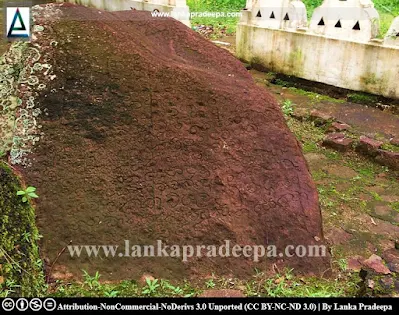
Pusulpitiya Raja Maha Viharaya (Sinhala: පුසුල්පිටිය විහාරය) is a Buddhist temple situated in Kotmale in Nuwara Eliya District, Sri Lanka.
History
The Mahabodhivamsa mentions Pusulpitiya as one of the 32 places where the saplings of Sri Maha Bodhi Tree in Anuradhapura were planted (Abeywardana, 2004). Therefore, the history of the Pusulpitiya Bodhi tree probably runs back to the 3rd century B.C. (Abeywardana, 2004).
The Sacred Tooth Relic
Pusulpitiya temple is historically linked with the sacred Tooth Relic of the Buddha. The relic was sheltered here several times during periods of political unrest in the country (Seneviratna & Polk, 1992). It is said that the relic was kept hidden here during the Maga’s rule (1215-1236 A.D.) in Polonnaruwa (Seneviratna & Polk, 1992). Also, it again found refuge here when the British entered the Kandyan Kingdom in 1815 (Seneviratna & Polk, 1992). At the time, the relic was kept concealed in a fracture on a Sapu-tree (Michelia spp.) of this temple from 6 to 22 April 1815 before it was again taken to the British-ruled Kandy.
Folklore
Pusulpitiya name A few legends are there associated with Pusulpitiya village and the temple (Abeywardana, 2004; Seneviratna & Polk, 1992; Wijesinghe, 2015). According to one folklore, an Indian Brahmin who was craving in taking treasures settled down in this area after his marriage. He was able to obtain a golden Pusul Gediya (an ash pumpkin) from a place of the Kotmale Oya after sacrificing his firstborn child (Abeywardana, 2004; Wijesinghe, 2015). On the way back with the treasure he recovered, the Brahmin felt thirst, and therefore, he kept the golden ash pumpkin aside and went in search of water. When returned, he saw that the golden ash pumpkin was missing and the earth has cracked at the place where he kept the pumpkin (Abeywardana, 2004). Grieved by this incident the Brahmin fell dead and thereafter this area was started to know among the people as Pusulpitiya (Abeywardana, 2004; Wijesinghe, 2015).
King Dutugemunu
Locals believe that Pusulpitiya is the place where King Dutugemunu (161-137 B.C.) spent his childhood (Seneviratna & Polk, 1992). According to them, the prince visited the temple to worship the Bodhi tree (Abeywardana, 2004).
Arhat Maliyadeva
It is also believed that one of the four golden Buddha statues brought to the country from India by Arhat Maliyadeva was deposited in the Pusulpitiya temple (Abeywardana, 2004; Seneviratna & Polk, 1992). The other three statues are said to be kept at Vattarama Viharaya, Madanwala Viharaya, and Diddeniya Viharaya (Abeywardana, 2004).
Monuments
The old shrine room This shrine was originally a Tempita Vihara but the walls added between the outer pillars have converted it into a two-storeyed building (Abeywardana, 2004). The upper floor consists of two sections and can be reached through a wooden flight of steps. The inner walls of the upper floor are decorated with paintings depicting Buddhist themes. Several valuable artefacts such as statues, caskets, manuscripts and brassware are preserved in this shrine room. A Makara Thorana (a Dragon's arch) said to be donated to the temple by King Buvanekabahu IV (1344-1353 A.D.) is also found here (Abeywardana, 2004; Wijesinghe, 2015).
This shrine was originally a Tempita Vihara but the walls added between the outer pillars have converted it into a two-storeyed building (Abeywardana, 2004). The upper floor consists of two sections and can be reached through a wooden flight of steps. The inner walls of the upper floor are decorated with paintings depicting Buddhist themes. Several valuable artefacts such as statues, caskets, manuscripts and brassware are preserved in this shrine room. A Makara Thorana (a Dragon's arch) said to be donated to the temple by King Buvanekabahu IV (1344-1353 A.D.) is also found here (Abeywardana, 2004; Wijesinghe, 2015).Vee-Atuwa
The Vee-Atuwa (the paddy store) found in the Pusulpitiya temple is said to be built to store the production of the paddy fields donated to the temple by King Kirti Sri Rajasingha [(1747-1782 A.D.) Wijesinghe, 2015]. The store is 9.23 m in length and 2.46 m in width and has been built on 12 short stone pillars (Abeywardana, 2004; Wijesinghe, 2015). It has been repaired in 1877 (Abeywardana, 2004; Wijesinghe, 2015).
Elephant tusks
The pair of elephant tusks presently preserved in the temple is thought to be the tusk of the elephant "Kadol" and is said to be a donation by Sattambi of Agalawatta, Ambatalawa (Abeywardana, 2004).
Besides the aforesaid monuments, a shrine room of the Kandyan tradition, a small Stupa, three inscriptions, Siri Pathula Gal (Buddha's footprints) and an old flight of steps have been found in the temple premises (Abeywardana, 2004; Wijesinghe, 2015).
See also
References
1) Abeywardana, H.A.P., 2004. Heritage of Kandurata: Major natural, cultural and historic sites. Colombo: The Central Bank of Sri Lanka. ISBN: 955-575-093-0. pp.225-227.
2) Seneviratna, A., and Polk, B., 1992. Buddhist monastic architecture in Sri Lanka: the woodland shrines. Abhinav Publications. pp.95-96.
3) Wijesinghe, T.K., 2015. Pauranika Sthana Saha Smaraka: Nuwara Eliya Distrikkaya (In Sinhala). Department of Archaeology (Sri Lanka). ISBN: 955-9159-36-4. pp.62-64.
2) Seneviratna, A., and Polk, B., 1992. Buddhist monastic architecture in Sri Lanka: the woodland shrines. Abhinav Publications. pp.95-96.
3) Wijesinghe, T.K., 2015. Pauranika Sthana Saha Smaraka: Nuwara Eliya Distrikkaya (In Sinhala). Department of Archaeology (Sri Lanka). ISBN: 955-9159-36-4. pp.62-64.
Location Map
This page was last updated on 24 April 2023



